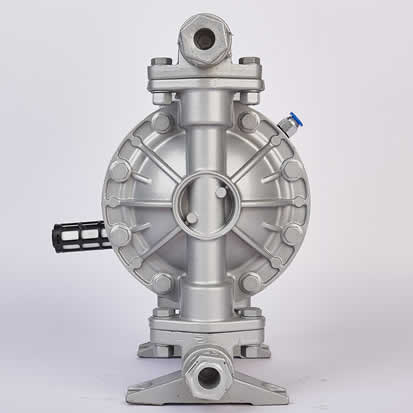Pneumatic diaphragm pump specific installation process:
1, pneumatic diaphragm pump installation and start:
The diaphragm pump is placed as close to the product as possible, so that the suction pipe line is short, the number of configuration parts is reduced, do not reduce the pipeline specifications. To extend diaphragm life, keep the pump as close to the liquid being pumped as possible, and install a slow pressure adjustment device to extend diaphragm life when inlet pressure exceeds 10 ft (3 m) column. If hard piping is installed, use a short hose connection between the pump and the piping. Hoses can slow down vibrations and distortions in the pipe, and a pressure stabilizer is recommended to further reduce pulses in the fluid.
2. Supply air to the diaphragm pump:
The gas supply pressure of metal diaphragm pump shall not exceed 125PSI(8.6BAR) and plastic pump shall not exceed 100PSI(6.9BAR). Connect the air inlet of the pump to the air source with sufficient capacity and pressure in accordance with the design requirements. If the gas supply line is a hard pipe, connect a short hose between the pump and the pipe to reduce distortion. In addition to the cover of the air intake, the weight of the air intake pipe and pressure regulating filter must also be supported in some way. If you don't support the pipe, you may damage the pump. A pressure regulating valve must be installed to ensure that the supply pressure does not exceed the specified range.
3. Check before diaphragm pump operation:
Before diaphragm pump work, check all the fixed objects to prevent relaxation, tighten the loose place to avoid leakage, with the method described in the card attached to the pump fixed.
4, diaphragm pump intake and start:
When starting, open the air valve about 1/2 to 3/4 turns. After the pump starts, open the air valve to increase the air flow to achieve the required flow.
5, pneumatic diaphragm pump exhaust:
If the diaphragm is broken, the extracted liquid or gas will enter the air port of the pump and be discharged into the atmosphere. When dangerous or toxic substances are extracted, they need to be piped to a suitable place for safe handling.
If the pump is sunk into the liquid operation, the gas should be expelled from the liquid surface, and the exhaust pipe should not be less than 1"(2.45CM). Reducing the size of the exhaust pipe limits the flow of gas and reduces the utilization of the pump. When the material level is higher than the pump, the outlet should be in a higher place to prevent siphon phenomenon.
At a certain temperature and humidity, the expelled gas is likely to freeze, and the use of gas drying can eliminate most of these problems.
6, pneumatic diaphragm pump after use:
If used to transport easily cured substances, in order to prevent damage to the pump, the pump should be thoroughly cleaned after each use. After use, the product left in the pump dries out or sticks to the pump, which can cause diaphragm and valve problems before the next start. In freezing temperatures, the pump must be drained after any use.
